
Diving in the dark can be challenging, which is why having a reliable dive light is essential for every diver. Dive lights are essential tools for divers, providing illumination in the underwater environment. It helps in night diving especially if you are a wreck or muck diver.
In this review, we’ll be looking at the top dive lights on the market, based on their brightness, battery life, size, and ease of use. We’ll also take a look at their durability and overall value, to help you make an informed decision when choosing the right dive light for you. Whether you’re a beginner or an experienced diver, we’ve got you covered, with dive lights suitable for all levels of diving.
So, without further ado, let’s dive into the world of dive lights and find the perfect light for your next scuba dive!
The 10 Best Dive Lights in 2023
In this section, we examine the top 10 dive lights currently available. Please find attached detailed information regarding each model’s upsides and downsides so you can make an informed decision.
1. ORCATORCH D710 Scuba Diving Light
The ORCATORCH D710 Scuba Diving Light is a top-of-the-line dive light that offers excellent performance and features for divers of all levels. This dive light boasts a powerful output of 3000 Lumens, providing ample illumination for even the darkest underwater environments. The D710 has a rechargeable battery that offers a long battery life of up to 7 hours, making it ideal for extended dives.
Key Features
Brand: ORCATORCH
The angle of 6 degrees for beams
Emitter for Luminus SST-70
Switch made from titanium alloy
Locking function for safety
Battery level indicator
Our Overall Review
4.6
Reasons to buy:
Reasons to Avoid:
Where to Buy?
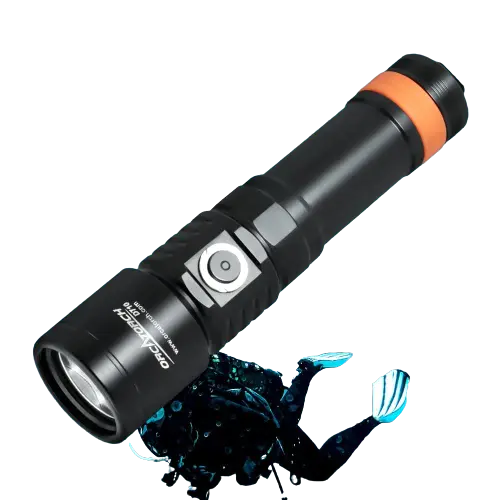
4.6 / 05
ORCATORCH D710 Dive Light
2. Wurkkos DL40 Diving Flashlight
The Wurkkos 5000 Lumen Scuba Diving Light is a top-performing dive light that offers a brightness level of 5000 Lumens. This makes it ideal for diving in low light conditions and for illuminating the underwater environment. The light is also compact and lightweight, making it easy to carry on dives.
It is also impressive that the LEDs can last up to 50,000 hours before they need to be replaced. Furthermore, the Wurkkos illumination distance can be extended to 400 meters when underwater, making it suitable for any depth. A magnetic side switch allows you to switch between four brightness settings easily.
Key Features
Brand: Wurkkos
Tempered glass lens
It is equipped with four Samsung LH351D bulbs
IPX8 waterproof rating
Four brightness modes are customizable
Guaranteed for 12 months and refundable for 90 days
Our Overall Review
4.8
Reasons to buy:
Reasons to Avoid:
Where to Buy?
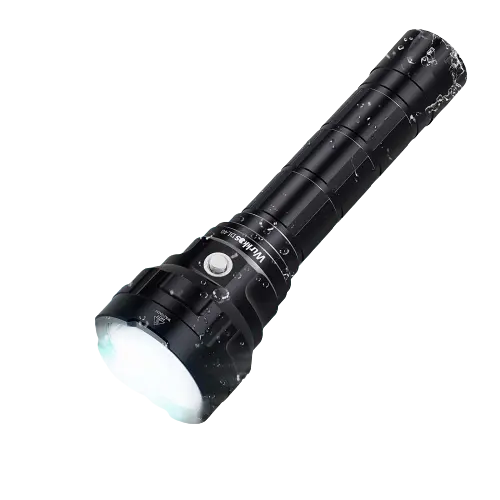
4.8 / 05
Wurkkos DL40 Dive Light
3. ORCATORCH D550
With attractive upgraded features, the Orcatorch D550 is a super lightweight and portable diving light. Its cover is crafted from aircraft-grade aluminum and hard-anodized to diamond-quality standards.
The Orca Torch models from Blue Reef are among the least expensive with rechargeable batteries among lights with rechargeable batteries. The wrist mounts were another selling point for me, as they free up one’s hands to do other tasks.
The D550 appealed to me because it had two adjustable brightness settings, whereas a more expensive model had a third set that was so low that it might not be practical for night dives. It required a rechargeable battery, but that more expensive model did not have one.
Key Features
Brand: ORCATORCH
Magnetic tail switch
Mode of strobe
Double-sided optical glass
Surfaces hard-anodized to diamond-grade
Aluminum alloy reflector
Our Overall Review
4.6
Reasons to buy:
Reason to Avoid:
Where to Buy?
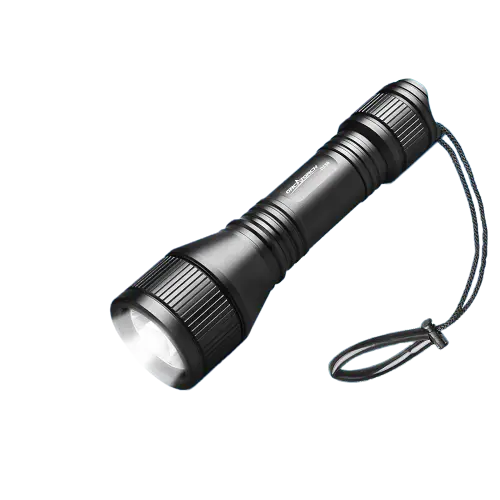
4.6 / 05
ORCATORCH D550 Diving Light
4. Genwiss Dive Light
The Genwiss Dive Light is a waterproof and durable underwater torch that is designed specifically for diving and snorkeling enthusiasts. It boasts a powerful LED light source that delivers bright and clear illumination even in deep water environments. This dive light is constructed with high-quality materials that provide resistance to corrosion and impacts, making it a reliable and long-lasting companion for underwater adventures.
With its compact size, lightweight, and long battery life, the Genwiss Dive Light is an essential tool for every diver and snorkeler. Whether exploring shipwrecks, and caves, or simply taking photos of the underwater world, the Genwiss Dive Light provides the bright and clear illumination necessary to make the most of every dive.
Key Features
Brand: Genwiss
Four Modes
Customizable wrist strap
Tubular handle
Safety lock function
Our Overall Review
4.3
Reasons to buy:
Reason to Avoid:
Where to Buy?
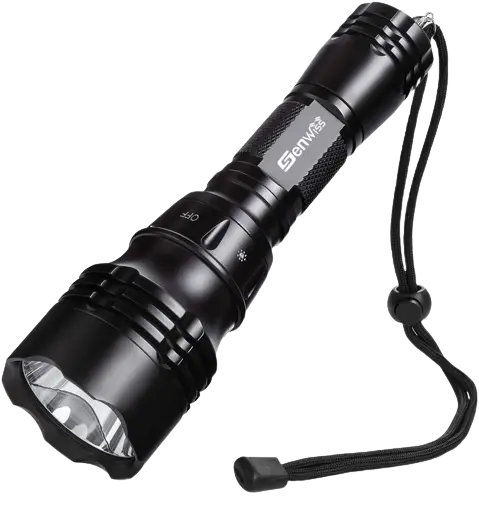
4.3 / 05
Genwiss Dive Light
5. SeaLife Sea Dragon Mini Dive Light
The SeaLife Sea Dragon Mini Dive Light is a compact and powerful underwater lighting solution for divers and snorkelers. This dive light is designed to fit in the palm of your hand, making it easy to carry and maneuver while diving. With its high-intensity LED bulb, the Sea Dragon Mini produces a bright and wide beam of light that illuminates the underwater environment and enhances the colors of the sea life.
A powerful 1300S Dive Light, 18650 2600mAh battery, and USB charger are all included in this Sea Dragon Mini 1300S Power Kit. This long-range light has a huge beam angle of 8 degrees and tremendous brightness. With one-handed operation, you can cycle through five different light modes with ease.
Key Features
Brand: SeaLife
Equipped with Luxeon V LED
Spot beam with an 8-degree angle
One button operation
Dual silicone o-rings
30,000 hours bulb lifespan
Our Overall Review
4.2
Reasons to buy:
Reason to Avoid:
Where to Buy?
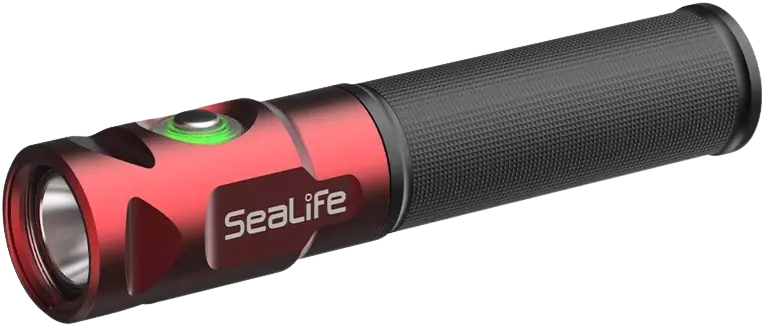
4.2 / 05
SeaLife Sea Dragon Mini Dive Light
6. Mares Aluminum Eos Torch
With 2300 lumens of brightness, the Mares Aluminum Eos Torch offers massive visibility. A total of four operating modes are available, including On, Low, Flash, and Off. With the help of a magnetic switch, you can change among settings.
Through its rechargeable battery, you can easily recharge the dive light using the USB cable included in the purchase. Its adjustable wrist strap is another advantage of the Mares Aluminum that you may enjoy.
Key Features
Brand: Mares
Four modes
Color: Orange Strobe
Excellent Beam
Tubular handle
Safety lock function
Our Overall Review
4.3
Reasons to buy:
Reason to Avoid:
Where to Buy?
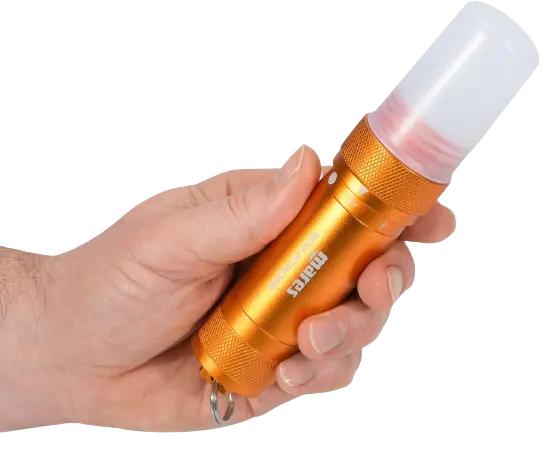
4.3 / 05
Mares Aluminum Eos Torch
7. PFSN DF-3000 Scuba Diving Lights
The PFSN DF-3000 is a type of scuba diving light that is designed to provide reliable and powerful illumination underwater. This light features a high-quality CREE LED bulb that can produce up to 3000 lumens of light, which is more than enough for most diving situations.
The PFSN DF-3000 is built with a durable and corrosion-resistant aluminum alloy body that can withstand the rigors of diving. It is also equipped with a rechargeable battery that can provide up to 2 hours of continuous use on a single charge.
Key Features
Brand: PFSN
Wide beam angle
Powerful illumination
Three lighting modes
Lightweight and portable
2 Years Brand Warranty
Our Overall Review
4.3
Reasons to buy:
Reason to Avoid:
Where to Buy?
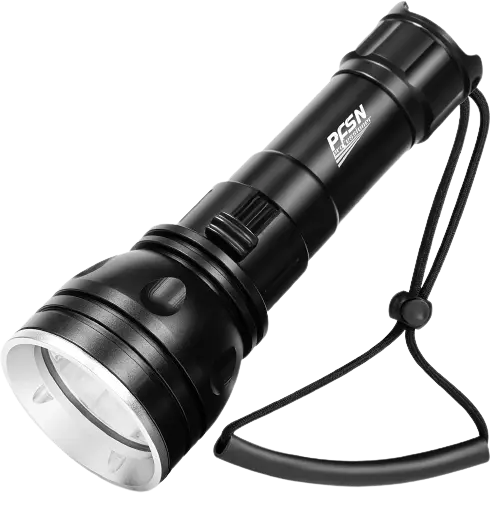
4.3 / 05
PFSN DF-3000 Dive Light
8. APLOS AP150 Dive Light
The Aplos AP150 Dive Light is a high-quality underwater flashlight designed for scuba diving and other water activities. It features a powerful LED bulb that can produce up to 15000 lumens of bright, white light, making it ideal for illuminating dark environments like caves, wrecks, and reefs.
It is built to last and is constructed from durable, aircraft-grade aluminum that is both waterproof and shockproof. It has a maximum depth rating of 100 meters (330 feet), which makes it suitable for most recreational diving activities. The light also has a rechargeable battery that can last for up to 2 hours at full power, depending on usage.
Key Features
Brand: Aplos
15000LM High-Brightness
Rotary switch with four modes
IPX8 Waterproof Rating
Built-in battery lasts a long time
Metal Case
Our Overall Review
4.4
Reasons to buy:
Reason to Avoid:
Where to Buy?
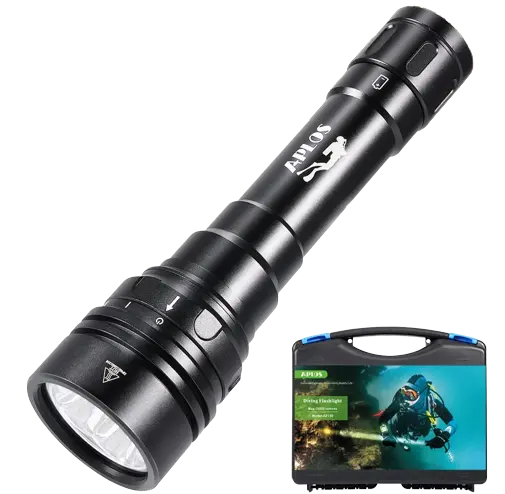
4.4 / 05
APLOS AP150 Dive Light
9. HECLOUD Diving Flashlight
HECLOUD is a leading manufacturer of high-quality diving flashlights that are known for their durability and reliability. The HECLOUD diving flashlight is designed to provide superior lighting and help you see clearly in the darkest conditions. The flashlight comes with a high-powered LED bulb that can produce up to 2000 lumens of light, making it one of the brightest diving flashlights on the market.
It has a long battery life ensuring that divers have enough power to complete their dive without worrying about the flashlight running out of power. We hope this HECLOUD Diving Flashlight has provided you with valuable insights into this outstanding piece of diving equipment.
Key Features
Brand: HECLOUD
Micro USB cable
Waterproof design
A flashlight comes with four modes
Easily adjust the brightness
Rechargeable Batteries
Our Overall Review
4.4
Reasons to buy:
Reason to Avoid:
Where to Buy?
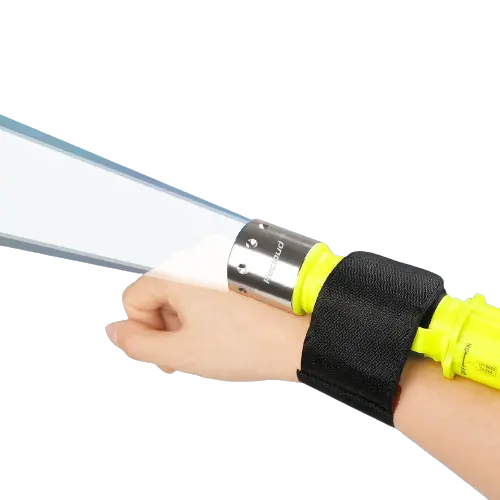
4.4 / 05
HECLOUD Diving Flashlight
10. GoZebra Dive Light
The GoZebra Dive Light is a top-of-the-line product that can make a significant difference in the quality of your underwater adventures. It is designed to withstand the extreme pressures and conditions of deep water. It is made from high-quality, corrosion-resistant aluminum alloy, which makes it lightweight, durable, and corrosion-resistant. The O-ring sealed design ensures that the dive light is waterproof, allowing you to take it to the depths of the ocean without worrying about leaks or water damage.
It is designed to be user-friendly and easy to operate. It features a simple one-button control that allows you to switch between different lighting modes and turn the light on and off. The compact and lightweight design of the dive light makes it easy to handle and maneuver, even in tight spaces.
Key Features
Brand: GoZebra
A bright LED chip is built-in
Hidden USB-C charging port
Aluminum alloy construction for durability
Widely Applicable
Battery level indicator
Our Overall Review
4.4
Reasons to buy:
Reason to Avoid:
Where to Buy?
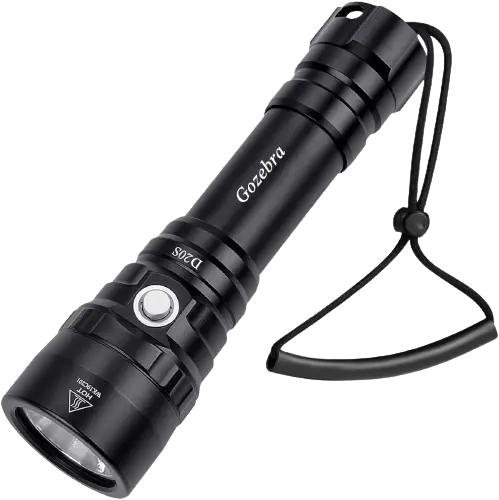
4.4 / 05
GoZebra Dive Light
How to Choose the Right Scuba Dive Light? Buying Guide
Dive lights are an essential tool for anyone who wants to explore the underwater world, whether for recreation or professional purposes. They not only provide visibility in low-light conditions, but they can also enhance the colors of marine life and reveal intricate details that might be missed otherwise.
Consider the factors mentioned earlier, such as depth rating, beam angle, brightness, battery life, size and weight, durability, and additional features, to help you narrow down your options.
- Cost
Determine your budget for a dive light. There are many options available at various price points, so you can find a light that fits your needs and budget. The cost is probably the most important factor when buying dive lights. It’s true that there are dive lights below $50, but when it comes to scuba gear in general, you get what you pay for.
To get quality lights that perform well and are reliable, you will need to pay a little more.
- Light Intensity
The light intensity of diving lights is typically measured in lumens, which is a measure of the total amount of light emitted by the light source. The light intensity of diving lights can vary widely, from a few hundred lumens to several thousand lumens.
The appropriate light intensity of your diving light will depend on the type of diving you plan to do and the visibility conditions you will encounter. For example, if you plan to do night diving or dive in low visibility conditions, you will need a diving light with a high light intensity to see clearly. In contrast, if you plan to dive in clear water with good visibility, the lower light intensity may be sufficient.
As a general rule, a diving light with a light intensity of at least 1000 to 1500 lumens is recommended for most types of diving. However, for night diving or diving in low visibility conditions, a diving light with a light intensity of 1000 lumens or more may be necessary.
It is important to note that the light intensity of a diving light is not the only factor to consider. The beam angle, battery life, durability, and other features of the diving light are also important considerations when choosing a diving light.
- Dive Light Battery
An underwater light can be powered by a few different types of batteries. It can be challenging to determine which one is right for you.
In my experience, the best battery must provide you with constant brightness and not suddenly die during night diving. The battery of a dive light is an important consideration when choosing a dive light. Here are some key factors to consider when evaluating the battery of a dive light:
- Dive lights can be powered by different types of batteries, including disposable alkaline batteries, rechargeable lithium-ion batteries, and nickel-metal hydride (NiMH) batteries. Rechargeable batteries are more eco-friendly and cost-effective in the long run, but they may have a shorter lifespan than disposable batteries.
- The battery life of a dive light is the amount of time it can operate on a single charge or set of batteries. Battery life can vary widely depending on the type of battery and the light intensity of the dive light. A longer battery life is generally preferred, especially for longer dives or for multiple dives in a day.
- If you are using a rechargeable dive light, the charging time is an important consideration. The charging time can vary depending on the type of battery and the charging method. Some dive lights can be charged via USB, which is convenient for travel, while others require a separate charging station.
- Some dive lights have a battery indicator that shows the remaining battery life. This can be helpful for monitoring battery usage and avoiding unexpected battery depletion during a dive.
- If you are using a dive light with disposable batteries, it is important to consider the cost of replacement batteries. Rechargeable batteries may have a higher upfront cost, but they can be more cost-effective in the long run.
When choosing a dive light, consider the type of battery that best suits your needs, the battery life, and the cost of replacement or recharging. It is also important to properly maintain and store your dive light battery to ensure its longevity and reliability.
- Size
Whether you can move underwater effortlessly depends on the size of your dive light. Additionally, lightweight, compact lights are very useful when you travel frequently.
In spite of this, novice divers should still invest in an oversized scuba light since their safety comes first. A modest-sized dive light may be used once you become more experienced, on the other hand.
The size of a dive light is an important consideration when choosing a dive light. Here are some factors to consider when evaluating the size of a dive light:
- Portability: If you are traveling to a dive destination, you may need a dive light that is lightweight and portable for ease of transport. Handheld dive lights are generally more portable than larger canister lights, but may not be as powerful or have as long battery life.
- Handling: The size and shape of a dive light can impact how it feels in your hand and how easy it is to use. Some dive lights are designed with ergonomic grips or finger ridges to make them more comfortable to hold, while others may be bulkier or have an awkward shape.
- Beam Angle: The size of the dive light can also impact the beam angle of the light. Smaller dive lights may have a narrower beam angle, while larger dive lights may have a wider beam angle. Consider the type of diving you plan to do and the visibility conditions when choosing a dive’s light size and beam angle.
- Durability: The size and construction of a dive light can impact its durability. Some dive lights are designed to withstand rough handling and impacts, while others may be more delicate. Consider the type of diving you plan to do and the conditions you may encounter when choosing a dive light with appropriate durability.
- Modes
High-end dive lights offer additional brightness settings to meet the demands of advanced divers, while most standard dive lights offer one to three brightness settings.
You should own a scuba light with strobe mode if you are a beginner to alert your dive buddy to any emergency situations.
- Materials
Aluminum is the material used in the majority of the dive lights reviewed above. In addition to being robust, rust-resistant, and very lightweight, this material also has a high degree of durability. Additionally, composite plastic is a common material. The ease of maintenance and exceptional anti-corrosion properties make this a great choice for inexperienced divers.
Different Types of Diving Lights
There are a wide variety of dive lights available on the market, and although they may be different in brands, functions, shapes, colors, or designs, they generally fall into one of three major categories. In terms of brightness level and diving environment, each type will work well.
Here are some of the most common types of diving lights:
- Primary Dive Lights: These are the most powerful and brightest dive lights and are designed to be the primary light source for diving. They are typically used for exploring underwater caves, shipwrecks, and deep-water environments. It is possible to light very dark areas with powerful primary torches, despite the fact that they can be quite heavy. Additionally, the batteries should last for a long time and be very durable.
- Secondary Dive Lights: These are smaller and less powerful than primary dive lights and are used as a backup or auxiliary light source. They can be used for signaling, navigation, and for illuminating smaller areas. These lights are primarily designed to serve as backups in case the primary fails. In order to only use your secondary light when needed, your secondary light should be small enough to fit in your pocket.
- Focus/Adjustable Dive Lights: These dive lights allow the user to adjust the focus of the beam, making them useful for illuminating distant objects, as well as close-up work such as reading gauges or maps.
- Wide-Angle Dive Lights: These dive lights have a wide beam angle and are designed for use in low visibility or murky water conditions. They are also useful for illuminating large areas such as reefs or coral walls.
- Video/Photography Dive Lights: These dive lights are designed specifically for underwater photography or videography. They are typically smaller and have a softer light output to prevent overexposure of images and videos. There is normally a duration associated with each power setting. To illuminate the scene evenly, video lights must have a wide beam angle and a high lumen power. In modern video lights, LED technology is most commonly used. For use as a focus and video light, purchase a powerful torch with multiple beam settings.
- Canister Dive Lights: These dive lights consist of a light head that is connected to a battery canister by a cable. Canister dive lights are typically more powerful and have longer battery life than handheld dive lights.
- Rechargeable Dive Lights: These dive lights can be recharged via USB or other power sources, making them more convenient and cost-effective in the long run than disposable battery-powered dive lights.
When choosing a diving light, consider the type of diving you will be doing and choose a light that is best suited to your needs.
Lighting Technology
Divers can choose from a variety of light heads and bulbs, including Xenon (incandescent), LED (light-emitting diode), and HID (high-intensity discharge).
- Xenon dive lights are usually the least expensive option. In addition to emitting warm natural light, these torches are more energy-efficient than LED or HID lamps. The downside of Xenon lights is that they are less bright and have shorter battery life than the other two options.
- HID dive lights are extremely powerful because they use electronics to boost the output of their bulbs. Based on the model, these lights emit a nearly white beam with hints of blue or green. Although HIDs are very delicate (so no rough handling), they are also quite expensive. As a result, HID torches are almost exclusively used for underwater photography and technical diving.
- LED dive lights have a high level of durability, efficiency, and power. Moreover, as technology and manufacturing have improved over the years, LED torches have now become more affordable and popular with divers of all types.
Frequently Asked Questions (FAQs)
Final Thoughts
In low-light conditions, dive lights provide illumination and are crucial safety devices. They are one of the first dive equipment you should purchase if you plan to pursue scuba diving as a hobby for these two main reasons.
Orcatorch’s D710 dive light is one of the best dive lights you can purchase. It meets nearly all your requirements as an all-around model. In addition to having high lumen output, the dive light is easy to use and has a long battery life.
Additionally, the Wurkkos 5000 Lumen Scuba Diving Light is a low-budget option. While it provides high quality, it is also competitively priced. You can expect a wide field of view from this model and robust construction.

There are many individuals who are passionate about scuba diving, but there are only a few who are equally passionate about writing about scuba diving gear. One such person is Sarah, a scuba diver and writer who is based in a coastal town in Australia.
Shakira’s love for scuba diving started when she was a teenager. She was fascinated by the underwater world and the beauty of the marine life that thrived beneath the surface of the ocean. As she grew older, her interest in scuba diving only intensified. However, it was not until she started working in a dive shop that she began to appreciate the importance of scuba diving gear.
Shakira quickly realized that having the right scuba diving gear could make or break a diving experience. She also noticed that many divers did not fully understand the importance of choosing the right gear or how to use it properly. This realization sparked her interest in writing about scuba diving gear.
Shakira began to write articles for scuba diving magazines and blogs, sharing her knowledge and expertise on various types of scuba diving gear. She covered everything from wetsuits and fins to regulators and dive computers. Her articles were well-researched and informative, and they quickly gained a following among scuba diving enthusiasts.
What set Shakira apart from other scuba diving writers was her ability to explain complex gear concepts in a way that was easy for divers to understand. She had a talent for breaking down technical jargon into simple terms, and her writing was always clear and concise.
In addition to writing, Shakira continued to dive and test different types of scuba diving gear. She wanted to ensure that her articles were based on firsthand experience and that she could provide practical advice to divers.
Today, Shakira is considered one of the leading writers on scuba diving gear. Her articles are highly respected among the scuba diving community, and she continues to educate and inspire divers around the world. Her passion for scuba diving gear is infectious, and she has helped countless divers make informed decisions about the gear they use on their underwater adventures.
